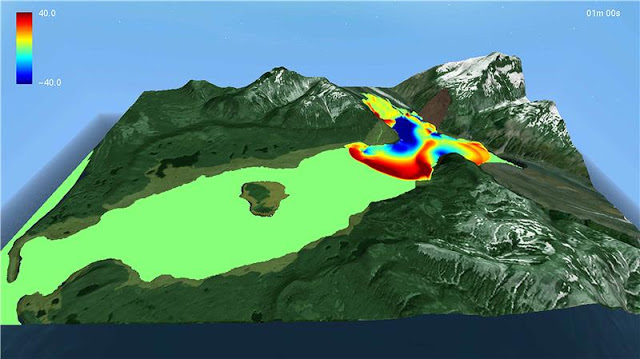

| Online: | |
| Visits: | |
| Stories: |

| Story Views | |
| Now: | |
| Last Hour: | |
| Last 24 Hours: | |
| Total: | |
New System Predicts the Behavior of Tsunamis in Less Than Ten Minutes
The group of Differential Equations, Numerical Analysis and Applications (EDANYA, from its abbreviation in Spanish) at the University of Málaga (UMA) and the Department of Languages and Computer Systems at the University of Granada (UGR) have created a simulator that predicts in less than ten minutes the behavior of tsunamis generated by landslides.
The system reduces up to a 60% the time spent in calculating different situations, with respect to the models used until now. With this simulation it is possible to immediately obtain information and thus facilitate a more effective performance of authorities and rescue teams.
The numerical model developed by the researchers allows to accurately predict the effects of the wave and perform a simulation before the actual events in real life. The impact of a tsunami on the coast can range from ten minutes to several hours from the time it occurs. The simulation takes between 5 and 10 minutes and provides information on the time it will take to land, the magnitude and height of the wave, the coastal penetration and the flood that it would cause, which allows to anticipate the course of action that should be followed in each case.
Specifically, the research has led to an article titled ‘Numerical simulation of tsunamis generated by landslides on multiple GPUs’, published in the Advances in Engineering Software journal. This work describes how the algorithm has been implemented so that several GPUs (graphic processing units) may be used simultaneously to accelerate the simulations. In addition, the article presents a representation of the disaster occurred in Lituya Bay, Alaska, in 1958. Said case presented the greatest wave ever to be registered associated with this type of events. The displacement of the slope of a mountain that dragged more than 30 million cubic meters of glacier over the bay generated a wave that flooded zones located to more than 500 meters above sea level, twice the height of the Cristal Tower in Madrid, the tallest building in Spain.
Although the usual mechanism of tsunami generation is the displacement of seabed faults, avalanches and landslides are common in fjords and lakes, and they can also be caused by the collapse of an island or an underwater landslide. The tsunamis generated by landslides have as their main characteristic that the amplitude of the wave is superior to that of the ones caused by earthquakes, although they tend to have a smaller zone of influence.
“These phenomena are frequent in mountain areas and they affect lakes as well as fjords. A landslide tsunami considered of great magnitude usually does not surpass twelve meters of height, that’s why the case of Lituya is of special interest, given its magnitude”, the authors of the paper told Fundación Descubre foundation.
The team has a multidisciplinary character and is made up of mathematicians, computer scientists and experts in physical modeling. This model is currently being validated by the National Tsunami Hazard Mitigation Program (NTHMP), a US association created to reduce the hazards of these phenomena along the coasts of its territory. In addition, another model developed by the EDANYA team is already being used at the National Institute of Geology and Volcanology (INGV, from its abbreviation in Italian) in Italy, at the Italian early warning system for tsunamis.
Mathematics in natural disasters
The researchers involved in the study work in geophysical flow modeling and computer simulation, that is, they recreate, through computer simulations, the behavior of the body of water when a giant wave or any other natural disaster occurs.
The use of said models also allows the validation of hypotheses about tsunami generation mechanisms. Thus, for example, in the 2004 tsunami, recorded as the one that has left more victims and disappeared people in history, was the result of the displacement of a fault of more than a thousand kilometers along the Indian Ocean and came to produce waves up to 30 meters high in some specific places. “This is explained by admitting that they were caused by submarine landslides caused by an earthquake in areas of submarine canyons. That is, in many cases, earthquakes, landslides and tsunamis usually develop together”, the researcher says.
The technique developed by the researchers can be applied in other events of a similar nature, such as floods caused by river overflows, coastal shoreline storms, spills or hurricanes, among others. The mathematical models used for this are very similar to those used in tsunami simulations, since the flood mechanism is essentially the same.
Currently, EDANYA researchers are developing models for simulating the evolution of sedimentary beds and coastal morphology, as well as their application in other fields, such as astrophysics.
The project has been funded by the Ministry of Economy and Knowledge of the Andalusian Regional Government through a project of excellence, and by the Ministry of Economy, Industry and Competitiveness. The group has also collaborated in similar studies with the Spanish Institute of Oceanography and the National Oceanic and Atmospheric Administration (NOAA, USA).
Contacts and sources:
Citation: Marc de la Asunción, Manuel J. Castro, José Miguel Mantas Ruiz, Pedro Ortega Salvador: ‘Numerical simulation of tsunamis generated by landslides on multiple GPUs’. Advances in Engineering Software.
Source: http://www.ineffableisland.com/2017/03/new-system-predicts-behavior-of.html



